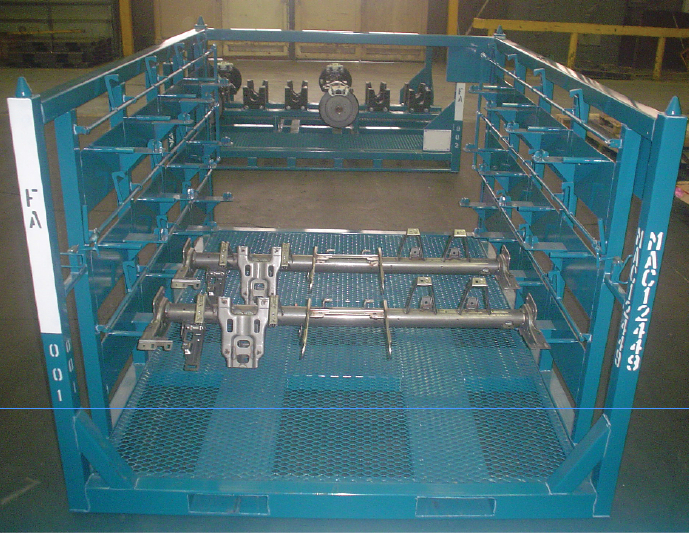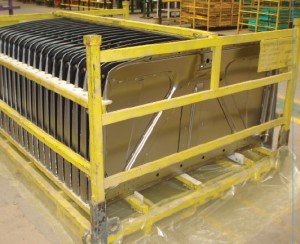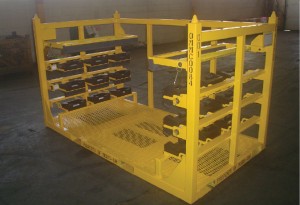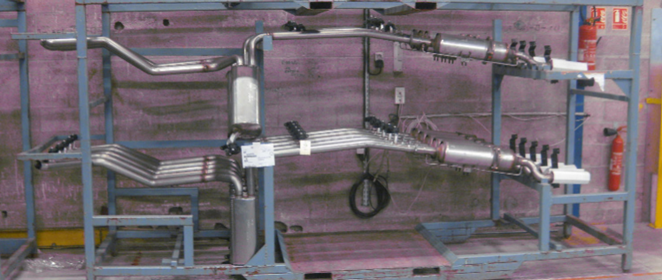The use of specialised metal racks is a common, albeit costly practice, but engineers are making them lighter and more modular
Although automotive packaging continues to become more standardised on a global basis – especially plastic pallets, containers and totes – non-standard or specialised packaging is still an essential element in the transport of many parts. One example would be returnable metal racks used primarily to carry large and heavy components such as body panels, engines, transmissions and cockpit modules.
These parts require greater protection or stronger packaging when being moved within plants or across continents. Such packaging is often bespoke as well. As metal racks are linked to the parts they help to move, they need to be considered as soon as part shapes and designs are determined, if not before. The right rack design will improve pack density, truck loading, maintenance, part safety and ergonomics.
Increasingly, manufacturers are looking for opportunities to introduce modular designs or standards wherever possible for metal racks, but that standardisation is complicated by both the part and packaging variation itself. Contract manufacturer and supplier Magna Steyr, for example, uses specialised metal racks for body shop apertures such as roofs, hoods and fenders, as well as cooling modules, headliners, and instrument panels for models such as the Mercedes G-Class and the Mini Cooper. According to Gerhard Hammerschmid, head of the firm’s supply chain competence centre, Magna Steyr uses ten different rack lengths across its five vehicle programmes, including seven widths and four heights, which equal about 280 different metal racks.
The use of metal racking is common and widespread among carmakers, driven by part shapes, protection and line-feeding strategies. Fiat India Automobiles uses specialised metal racks to transport parts from suppliers to its plant near Pune. It also uses them for sequencing and kitting parts from its warehouse to the production line. According to Kalpesh Pathak, vice-president of corporate supply chain, the decision to use specialised racks depends on part shape, transport distance and quality concerns. “Standardised racks are preferable for long distance vendors in order to optimise our transportation costs,” he explains. “However, we use specialised metal racks where part geometry does not enable us to use standard racks and where specific holding, locking or placement is required to avoid part-to-part contact and avoid damage during transport.”
"We use specialised metal racks where part geometry does not enable us to use standard racks and where specific holding, locking or placement is required to avoid part-to-part contact and avoid damage" - Kalpesh Pathak, Fiat India
Specialised metal racks are commonly used for the skin panel, seat set, bumper, dashboard, muffler, engine and suspension, among others. “As we introduce more parts for sequencing and kitting, we will increase our use of specialised metal racks to minimise constraints,” Pathak says.
Another OEM in India, Mahindra & Mahindra, generally uses specialised metal racks for the transport and line feeding of aggregates, high-and-medium value sheet metal parts, and some trim parts, says Gavi Ishwar, manager of the company’s packaging centre of excellence. “We also use them for transporting some subassemblies from suppliers that are located within a 200km radius of our plants.”

Along with providing part protection and separation, Schweers points out that specialised racks must also orient correctly at the line side, as well as to assembly workers’ movements. Having an adequate supply of specialised metal racks is also essential; in this respect, Surgere helps the customer to obtain the correct quantity of racks and to identify a control plan for maintaining them.
Mekins Industries offers specialised steel racks to the automotive sector in India. CEO Mayank Agarwal says the trend in India is for end-to-end service, including concept design, prototype build, trials, mass production and maintenance. Besides logistics costs, he adds, the main criteria for using specialised metal racks are whether the part is an inner or outer panel and to what extent part-to-part contact is acceptable. Inner panels might allow contact and minor scratches, which may not be visible to end users. “For example, outer panels and door assemblies ship in specialised metal racks and inner stampings ship in standardised racks,” he says.
Big and clunky
As racks are often heavy and expensive to ship, most companies try to limit their use to products located closer to assembly lines. Jasjit Sethi, CEO of logistics provider TCI Supply Chain Solutions, based in Gurgaon, says its highest demand for specialised metal racks are in vendor parks, which are closed-circuit networks. “Here, the cost of the reverse leg is negligible and the speed of the JIT and JIS processes increases with a ready-to-use part,” he says. TCI also uses specialised metal racks for local suppliers within a 30km radius. For example, in Pune, Fiat, Tata Motors, Volkswagen and General Motors all produce within 100km with their suppliers nearby.
Sethi says most larger parts originate near the assembly plant, such as axles, gearboxes and engines, and these typically flow from one OEM plant to another instead of from the tier one to the OEM. TCI ensures that parts are secure in the rack. “A small axle may fit easily, but five or six flat parts must be secured by design or by dunnage,” says Sethi.
Gerhard Hammerschmid says Magna Steyr’s use of specialised metal racks changes depending on part quality, price, loading or unloading requirements and materials used, such as aluminium instead of steel. He also emphasises that they should be used to the least degree possible because of transport costs. “For us, the transportation cost is critical due to the distance between our plant in Graz, Austria and our suppliers,” he says. “The idea is to use low cost, standardised packaging for long distance transportation, then special racks for local, short distances.”
As its specialised rack network develops. Surgere has found improvements in packaging tare weight, density and part protection, driving transport savings, helping in-plant labour, and reducing damage, according to Schweers.
Schweers notes that the use of collapsible specialised racks is more common in Europe, but it is growing in the US. He says that aluminium racks are much more expensive and not as common as steel ones. They are more difficult to weld although they are lighter in weight while still being strong.
Mahindra & Mahindra also designs standard footprints with minimum varieties to maximise the cubic utilisation, says Ishwar. Previously, it had used non-foldable specialised metal racks for transporting parts over long distances. To improve return transport efficiency, foldable specialised racks were introduced in 2010 for shipping from tier one suppliers to the carmaker’s assembly plant; these enabled a return ratio of three to one.
A move towards the modular
TCI’s Sethi acknowledges that there can be a tendency to customise too much and make racks inflexible for alternative uses. “The specialised metal racks have a much longer payback period, so the utility over their life span is an important factor,” he says.
Carmakers often try to add as many standard features to the specialised racks as possible. Around 70-80% of Mahindra & Mahindra’s assembly line parts use specialised racks, but Ishwar says the company is working on standardising the racks’ outer structures with modular internal fitments and separators, in part to avoid redundancy after a product change. “Our objective is to use standardised metal racks as much as possible, with minor customisation,” says Ishwar.
Magna Steyr’s Hammerschmid says that the key is to use the same outer frame, but change the internal material. For example, hoods need separators, which are plastic. If the specialised metal rack would be in use later for a similar part, then it is only necessary to change the plastic separator.
Surgere provides specialised rack designs for each part that may also be suitable for a part family. “For example, for interior door trim panels, we try to design one rack that can handle all four panels and [those] for a complementary vehicle for an entire assembly plant,” says Schweers.
Sethi says the idea is to standardise the size for ease of handling and within the vehicle’s inner dimensions, and to make it rollable and stackable at the same time, while making customisation as modular as possible.
Agarwal at Mekins Industries suggests that specialised metal racks will continue to move towards reusability. “Rack frames are set in standard sizes, with footprints that cube the conveyance,” he explains. “Dunnage designs focus on reusability and removability. The life of the steel skeleton frame is 10-20 years, whereas the part-specific dunnage is good for 3-7 years.”
Michigan-based Advanta Industries, which specialises in manufacturing automotive material handling equipment, serves Ford, Chrysler, Toyota, General Motors, Hyundai, Kia, and BMW, as well as tier one suppliers.
Adam Drake, vice-president, sales and business development, says standardised metal racks are mostly for parts that can be bulk packed and do not have an automotive finish class of ‘B’ or higher. “More than 90% of part commodities have an automotive finish class of ‘B’ or higher and require a unique rack design
that provides part protection and maximises rack and trailer density,” says Drake.

For example, certain roof racks will be changing from steel to aluminium in 2015. “They will be robotically loaded and unloaded, which means that the dimensions of the rack must be extremely precise. The problem is that the contents could shift during transport,” he says.
Advanta’s highest demand is for the specialised metal rack to do more and more. “The issues are more than just transportation and safety,” Drake remarks. ‘There needs to be more lift assists and less human error. Fabricators must become leaner.”
Maintenance and handling
Along with weight reduction, another challenge is maintenance. “Although specialised metal racks may be foldable, a lot of effort is required to remove the pillars and other parts of the rack, so the question is how to simplify it,” says Hammerschmid. “Preventative maintenance is also very expensive. Therefore, we would remove the small plastic parts instead of the large metal parts. In such circumstances, 90-95% of the rack would be usable for six or seven years.”
Within the past two years, Fiat India has made changes in the storage pockets and partitions for specialised racks by replacing polypropylene sheets with a special fabric that protects the parts better and is more durable and low maintenance. This has helped the OEM to reduce the maintenance cost of its specialised racks.
Fiat India has faced a number of other challenges to using specialised metal racks, including non-standard and poor quality trucks, as well as facilities that were not suited to handling various types of equipment, and finally poor rack maintenance – all of which Pathak says it has successfully addressed.
Ishwar says that Mahindra & Mahindra also sees issues with the availability of material handling equipment at loading points, warehouses and crossdocks. “Many of our suppliers do not have forklifts, so we must provide them,” he explains.
Tier one standards
Armin Hans, Tenneco’s European logistics and packaging engineer, says the tier supplier uses about 15% specialised metal racks and 85% standardised ones to maximise its truckload utilisation as well as consider OEM requirements for storage and sequencing. “The main factors that determine whether we would use a specialised metal rack or a standardised one are part design, quality and delivery forms and frequency, such as JIT, JIS, batch, etc.,” he says.
Tenneco’s full exhaust systems ship 80% in specialised metal racks. These include flex pipes, dampers and chrome-polished end pipes. “For pre-transport, we use standardised racks for shipping to the 3PL. Then, the sequencing rack is the [OEM’s] design for the most part. It requires a special robotic arm
for automated handling, including feeding heavy parts into the rack.”
Hans says that for its less frequent shipments, Tenneco is more likely to use specialised metal racks, whereas for daily shipments it checks on whether it can use standardised racks.
“One of our challenges is to cover as many product variants as possible with one specialised rack,” he says. “Specialised racks for a specific project could be in use for five or six years. When the project is completed, it does not make sense to redesign the existing rack.”

Looking ahead, Hans says there is a big opportunity to standardise metal racks for ocean transport. “Every supplier has its own. At this point, about 80% are one-way and 20% are returnable,” he says.
Specialised racks are expensive, heavy and time-consuming both to procure and manage. Such equipment takes up capital spending that many would consider ‘non-core’ to carmakers. However, the protection and storage they provide are impossible to do without. A shift towards modular designs among packaging engineers seems to be strengthening, even while the use of specialised metal racks will likely grow as product variations increase and there are more space constraints at plants and warehouses.


































